
English (959)
Children categories
BRAC Founder Fazle Abed Receives “Entrepreneur for the World” Award
25 November 2009, Dhaka. The first ever “Entrepreneur for the World” Award in the Social Entrepreneur category was awarded to BRAC Founder and Chairperson Fazle Hasan Abed. He received the award during a ceremony at the World Entrepreneurship Forum held on November 19, 2009 in Lyon, France.
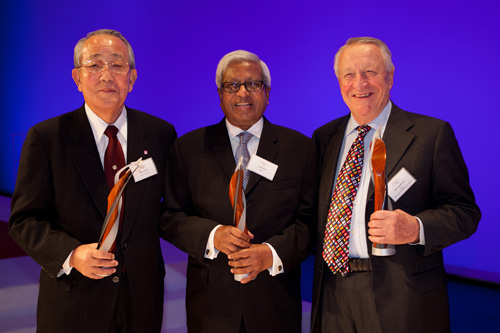
photo courtesy: Pierto/Sipa Press
The World Entrepreneurship Forum was established by EMLYON Business School, the leading European business school in entrepreneurship, and KPMG, the leading tax, audit and advisory services company. The Forum is founded on the conviction that the entrepreneur is a creator of wealth and social justice. The World Entrepreneurship Forum awards started in 2008 and 2009 is the first year that the Social Entrepreneur category was included in the awards category.
Patrick Molle, president of EMLYON Business School, and Jean-Luc Decornoy, chairman of KPMG SA, presented Abed with the award “to highlight his more than 30 years at the head of one of the largest non-government development organisations in the world. This award is granted to a personality who has greatly improved the life of the community. Fazle Hasan Abed is a social worker and visionary. He left his job to devote himself to Bangladesh’s War of Independence. Abed initiated BRAC, the largest non-government development organisation in the world in terms of size and diversity of interventions.”
“Entrepreneur for the World” Awards are presented in four categories: in the Entrepreneur category Dr. Kazuo Inamori, founder of Kyocera Corporation and KDDI Corporation in Japan received the award; Mary Robinson, former President of the Republic of Ireland, received the award in the Politician category; and in the Expert category, Bert Twaalfhoven from the Netherlands, founder of 51 high tech companies in 11 countries was awarded.
Fazle Hasan Abed has been honoured with numerous international awards for his achievements within BRAC, among which: the Ramon Magsaysay Award for Community Leadership (1980); Unicef's Maurice Pate Award (1992); Olof Palme Award (2001); Gates Award for Global Health (2004); Henry R. Kravis Prize in Leadership (2007). Clinton Global Citizenship Award (2007) as well as several honourary degrees from renowned universities including Columbia, Yale and Oxford.
United Nations Democracy Fund to support BRAC’s democracy and governance initiative
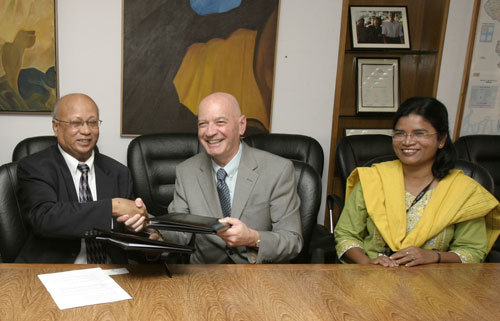
11 November 2009, Dhaka. BRAC and the United Nations Democracy Fund (UNDEF) signed an agreement on Wednesday to support BRAC’s initiatives to strengthen grassroots democracy and local governance. Under the agreement UNDEF will provide support to BRAC’s Social Development Programme for implementation of a project titled Active Citizens and Accountable Local Government (ACALG).
The agreement was signed by Mr. Roland Rich, Executive Head of UNDEF and Dr. Mahabub Hossain, Executive Director of BRAC, at the BRAC Centre in Dhaka. Tania Zaman, Director, BRAC Chairperson’s Office (Chief of Staff), Anna Minj, Director, Social Development Programme and head office staff of BRAC Social Development Programme were also present in the signing ceremony.
Mr. Rich stated, “One of the reasons we were attracted to BRAC was that BRAC is giving people voice in their own communities to deal with government authorities. And voice is fundamental to democracy.” He added that BRAC was a strong and well-established group who can deliver the task.
The Active Citizens and Accountable Local Government (ACALG) project is a two year project which will be implemented in the districts of Bogra and Jessore. The project aims to create conditions for more active civic engagement among rural and semi-urban poor citizens and to strengthen capacities of local government to provide more accountable and effective governance.
The objectives of the project are to develop capacities of both the local government and rural citizens to plan and deliver accountable and more equitable services and resource allocation, and to create accessible sources of information about civic rights, local government and its services. Moreover, the project aims to transform bureaucratic practices at the local level to be more responsive to the needs of the poor.
BRAC participates in Global Road Safety Conference

25 November 2009, Dhaka. The First Global Ministerial Conference on Road Safety was held at the Russian Federation in Moscow on 19 - 20 November 2009. Ahmed Najmul Hussain, Director, BRAC attended the conference as part of a four member country delegation headed by Bangladesh Communication Minister Sayed Abul Hussain. Mr. Hussain gave a presentation on BRAC Road Safety programme achievements.
The Conference was opened by Russian President Dmitry Medvedev who called for urgent global action on road safety. More than 70 ministers and 1000 high-level representatives of governments, non-governmental and international organisations from nearly 140 countries attended the first-ever governmental- Minister-level meeting on road safety. In a statement delivered by Director-General of the United Nations office in Geneva, Mr. Sergei Ordzhonikidze, and United Nations Secretary-General BAN Ki-moon stressed the importance of regional commissions’ work for road safety.
The Conference adopted a declaration aiming to reduce the global toll of road deaths. The document declares 2011-2020 a decade of action for road safety, it appeals to the international donor community to ensure funding for global, regional and national road safety programmes and it emphasizes the necessity to evaluate progress. The declaration will be the basis for the fifth UN resolution on the subject.
In the closing session speakers from the WHO, World Bank, FIA Foundation and UK transport minister Paul Clark MP joined the head of the Russian traffic police, General Victor Kiryanov, and the Russian Interior Minister, Rashid Nurgaliev, to endorse the proposed decade and begin to set out plans for global coordination of the unprecedented effort to reduce road traffic injuries.
“it is tremendous to see these children given the opportunity of a basic education which their parents never had"
10 January 2010, Dhaka. Expressed Mr. John Denham, UK Secretary of State for Communities and Local Government while visiting BRAC Primary education programme in one of BRAC schools in Korail Slum, Dhaka. He was accompanied by Stephen Evans, the British High Commissioner, Chris Austin, DFID Country Representative, Dr. Mahabub Hossain, Executive Director of BRAC, Safiqul Islam, Director of BRAC Education programme and other british delegates including Neil O'Connor, Director, Cohesion Directorate, Department for Communities and Local Government; Sarah Montgomery, Private Secretary, Department for Communities and Local Government; Jake Sumner, Adviser, Department for Communities and Local Government and Mohammed Abdul Aziz, Adviser, Department for Communities and Local Government.

The Secretary talked to the students and their teacher and observed class activities. Mr. Denham said, “I think it is tremendous to see these children given the opportunity of a basic education which their parents never had. This education would improve their lives in the future. And I think the work that BRAC is doing and the British Government is supporting by working with BRAC is really important. It does not matter where you are in the world or what your background is, you should have the opportunity to make the most of your talent and ability and that is what I think this school is doing.”
Fazle Hasan Abed To Be Knighted For Work on Poverty
 31 December 2009, Dhaka. Founder and Chairperson of BRAC, Fazle Hasan Abed, is to be knighted by Her Majesty Queen Elizabeth II for services in tackling poverty and empowering the poor in Bangladesh and more globally. Abed is to be appointed Knight Commander of the Most Distinguished Order of St. Michael and St. George (KCMG). He is the first person of Bangladesh origin to be honoured with a knighthood by the British Crown since 1947. Abed is the second person in his family to be honoured with a knighthood. His grand uncle, Justice Nawab Sir Syed Shamsul Huda, was knighted by the British Crown in 1913.
31 December 2009, Dhaka. Founder and Chairperson of BRAC, Fazle Hasan Abed, is to be knighted by Her Majesty Queen Elizabeth II for services in tackling poverty and empowering the poor in Bangladesh and more globally. Abed is to be appointed Knight Commander of the Most Distinguished Order of St. Michael and St. George (KCMG). He is the first person of Bangladesh origin to be honoured with a knighthood by the British Crown since 1947. Abed is the second person in his family to be honoured with a knighthood. His grand uncle, Justice Nawab Sir Syed Shamsul Huda, was knighted by the British Crown in 1913.
BRAC Founder Fazle Hasan Abed knighted at Buckingham Palace
03 March 2010, Dhaka. Fazle Hasan Abed, the founder and chairperson of BRAC, was knighted on Tuesday in a special ceremony at Buckingham Palace in London. The Knighthood, announced in the Queen’s New Year`s Honours List, was awarded in recognition of Sir Fazle’s services to reducing poverty in Bangladesh and internationally.
The Investiture Ceremony was held by Prince Charles, the Prince of Wales, who represented Queen Elizabeth II. While conferring the knighthood, Prince Charles mentioned to Sir Fazle that he remembered visiting BRAC in Bangladesh and thanked him for his long service in reducing poverty.
Leaders from around the world have congratulated Sir Fazle on his Knighthood. Queen Rania of Jordan, in her message to Sir Fazle, wrote:
“More than just recognition of your tireless efforts to relieve poverty and disease in Bangladesh and abroad, this Knighthood gives further momentum to your reputation as one of the most dynamic and selfless humanitarians of our time.”
Sir Fazle was appointed Knight Commander of the Most Distinguished Order of St. Michael and St. George (KCMG). Following tradition, Sir Fazle knelt on a velvet Investiture Stool to receive the accolade, which was bestowed using the sword which King George VI used when, as Duke of York, he was Colonel of the Scots Guards. Sir Fazle was then invested with a Neck Badge and Star carrying the Insignia of the Order of St. Michael and St. George.
Sir Fazle is the first person of Bangladesh origin to be honored with a Knighthood by the British Crown since 1947. Sir Fazle’s wife, Lady Sarwat Abed, and daughter and son, Tamara and Shameran, were present at the ceremony at Buckingham Palace.
5 day workshop on “South Asia Midwifery Strategy Planning ” at Dhaka
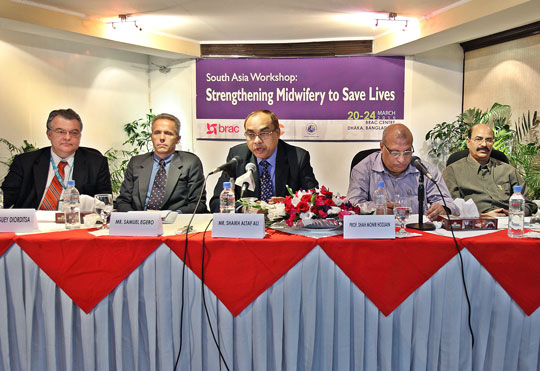
25 March 2010, Dhaka. International Confederation of Midwives (ICM), United Nations Population Fund (UNFPA) and BRAC, Bangladesh jointly organized a Five (5) day workshop, from 20-24 March 2010, on “South Asia Midwifery Strategy Planning” at BRAC Centre, Mohakhali, Dhaka. The United Nations Population Fund (UNFPA) and the International Confederation of Midwives (ICM) jointly launched the global Investing in Midwives Programme in 2008 for strengthening midwifery skills and workforce in low-resources countries for the achievement of MDG-5, focusing on 4 major areas for better midwifery services: education, association strengthening, regulations and advocacy. After initiating its activity in African region, the joint initiative is now focusing its activity towards Asia and Pacific region. The programme is now focusing on the South Asia region as a continuation of its initial initiative.
The objective of this 5 day workshop is to develop a midwifery services framework model for strengthening midwifery education, regulation and association in countries of South Asia, based on gaps and priorities identified and to launch work plans for next 2-3 years. The workshop focused on the situation analysis of existing gaps in midwifery services in 6 South Asian countries namely Afghanistan, Pakistan, Nepal, Bhutan, Bangladesh, and India. Based on that a midwifery service framework is developed and strategic planning is put in place for strengthening midwifery in this region. The workshop also focused on networking and knowledge sharing.
Mr. Shaikh Altaf Ali, Honorable Secretary, Ministry of Health and Family Welfare, Bangladesh, Prof. Shah Monir Hossain, Director General, DGHS, Mr. Mohammad Abdul Qayyum, Director General, DGFP, Bridget Lynch, President of ICM, Agneta Bridges, Secretary General of ICM, Arthur Erken, UNFPA Representative of Bangladesh, Vincent Fauveau, Senior Technical Advisor, UNFPA, Abigail Kyei, International Midwive Advisor and Geeta Lal UNFPA Midwives Programme Coordinator, participants from national and international organization and agencies were present in the inaugural session of this five day workshop and gave their valuable views in this regard.
BRAC chairperson commits to large scale poverty alleviation in Tanzania
13 April 2010, Dhaka. BRAC Founder and Chairperson Sir Fazle Hasan Abed met President of Tanzania, H.E. Jakaya Mrisho Kikwete, on April 11 at 12 pm at the President's Palace in Dar es Salaam.
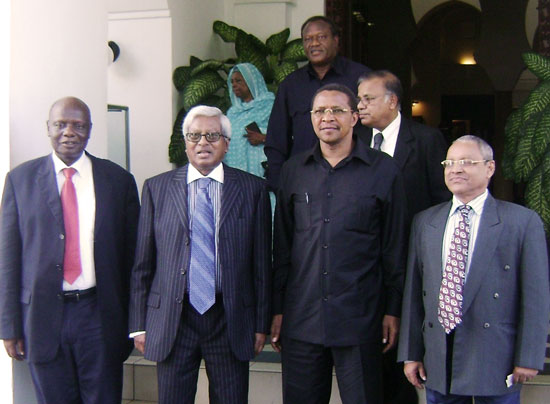
BRAC Founder and Chairperson Sir Fazle Hasan Abed (2nd Left) met President of Tanzania, H.E. Jakaya Mrisho Kikwete (3rd Left)
In the meeting, Sir Fazle updated the President on BRAC's programmes in Tanzania which, within less than four years, is already providing microfinance and other livelihood development services to over 500,000 poor families across 18 of the country’s 26 regions. 'We want to have the greatest impact on poverty within the shortest possible timeframe', Sir Fazle said while outlining his vision for BRAC in Tanzania. He emphasised the importance of appropriate policy and regulatory architecture for deeper outreach of microfinance and other services to the rural poor.
The President expressed his deep appreciation of BRAC's work in Tanzania, especially its strong focus on rapidly scaling up microfinance services throughout the country.
During the meeting, Sir Fazle was accompanied by the Executive and Deputy Executive Directors of BRAC International and the Country Head of BRAC in Tanzania.
BRAC- PMNCH analyse Millennium Development Goals of maternal health and child mortality
28 April 2010, Dhaka. BRAC and the Partnership for Maternal, Newborn and Child Health (PMNCH) have jointly organised a special meeting titled, “Mothers and Babies Speak: Moving Forward with Lessons on Maternal, Neonatal and Child Health (MNCH)” on April 28, 2010 at BRAC Centre, Dhaka from 10:00am-12:00pm. The PMCNH is a global alliance of over 300 members committed to achieve MDGs 4 and 5.
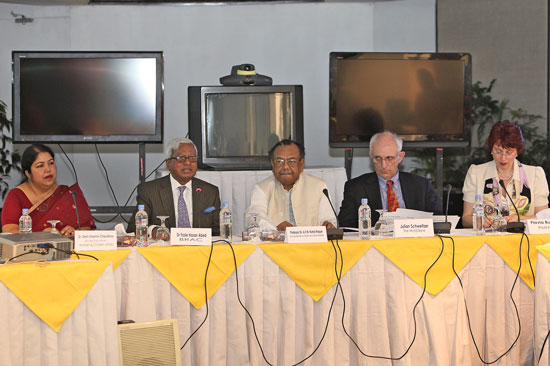
(From Left) State minister of Women and Children Affairs Dr. Shirin Sharmin Chowdhury, Founder and Chairperson of BRAC Sir Fazle Hasan Abed, Minister of Health and Family Welfare Prof. Dr. A.F.M Ruhal Haque, Acting Vice President of Human Development Network of the World Bank Dr. Julian Schweitzer
This meeting was specifically convened to review the key developments in Millennium Development Goals (MDGs) 4 and 5 in Bangladesh, discuss the role and contribution of public-private partnership and take lessons of Bangladesh to the upcoming MDG Summit in New York in September.
Sir Fazle Hasan Abed, founder and chairperson of BRAC, welcomed the international and national participants drawing attention to commitments in terms of financial, physical and technical investments to MDGs 4 and 5, particularly, maternal health. Sir Fazle inaugurated the meeting with a video message from Sarah Brown, the First Lady of United Kingdom and Co-Chair, Maternal and Child Health Leadership Group. In the video message, Mrs. Sarah Brown accentuated the role of global leaders to maternal mortality campaign. She continued to express her gratitude to Prime Minister Sheikh Hasina for her role in Bangladesh for the improvement of maternal, newborn and child health and also highlighted BRAC’s contribution, particularly, Sir Fazle Hasan Abed to this arena in Bangladesh and beyond.
Prof Dr. Shahidullah, Pro-Vice Chancellor, Bangabandhu Sheikh Mujib Medical University (BSSMU) reviewed the state of maternal, neonatal and child health in Bangladesh emphasising successes, challenges and gaps in health sectors. He said that Bangladesh is on track for MDG 4, but not for MDG 5 and hence, it is crucial to address challenges and gaps in order to improve the situation. Dr. Kaosar Afsana, Associate Director, BRAC Health Programme discussed about the critical role of public-private partnership in achieving MDGs 4 and 5. In this context, she stated that BRAC has created significant improvement in maternal and neonatal health in urban slums and rural districts of Bangladesh. Mr. Anir Chowdhury, Policy Advisor and Head of Access to Information Programme of Prime Minister’s Office, drew attention to the role of ICT and e-health in digitalizing Bangladesh and how private sector collaborations are contributing to achieving health MDGs.
Prof. Dr. A.F.M Ruhal Haque, Hon’ble Minister, Ministry of Health and Family Welfare participated in the event as the Chief Guest and stressed that the upcoming G8 and MDG review would mobilise financial investments in maternal health and child health.
Dr. Julian Schweitzer, Chair, the PMNCH and Acting Vice President, Human Development Network of the World Bank, and Dr Flavia Bustreo, Director, the PMNCH attended the meeting as the Special Guests. Distinguished Members of the Parliamentarians, Board Members of the PMNCH, Director General Health Services and UN agencies and development partners, civil society members, development practitioners and researchers were present in this special event.
This meeting was convened as the inaugural event for the Board meeting of the PMNCH to be hosted by BRAC during April 28 – 30 in Dhaka, Bangladesh.
Understanding agricultural transformation in Asia
24 April 2010, Dhaka. Agricultural transformation in five countries, Vietnam, Korea, Bangladesh, India and Thailand were a major focus of the seminar, where delegates deliberated on the critical aspects underlying the dynamics of agricultural transformation as has occurred in the five countries during the past four to five decades. The country papers presented in the seminar provided a comprehensive assessment of the important drivers of agriculture transformation. The drivers include socio-economic factors, demography, trade reforms and the global climatic change induced factors.

Prominent delegates who attended the seminar included Mr. Ashvin Dayal, Managing Director, Rockefeller Foundation(Asia), Bangkok; Prof. Seong Woo Lee of Agricultural Economics and Rural Development Program, Seoul National University , Korea; Mr. Sang-Ho Choi, Extension Planning Division, Rural Development Administration, Republic of Korea; Dr. Kazi Ali Toufique, Bangladesh Institute of Development Studies (BIDS ), Bangladesh; Dr. Mahabub Hossain, Executive Director, Bangladesh Rural Advancement Committee (BRAC ), Dhaka; Prof. Ramesh Chand, Director, National Centre for Agricultural Economics and Policy Research (NCAER ), New Delhi, India; Prof. Amita Shah, Director, Gujarat Institute of Development Research (GIDR ), Ahmedabad, Gujarat, India; Prof. Do Kim Chung, School of Economics and Rural Development, Hanoi Agricultural University (HAU ), Hanoi, Vietnam; Dr. Nguyen Viet Dang, Faculty of Economics and Rural Development, HAU, Hanoi, Vietnam; Mr. Phrek Gypmantasiri Faculty of Agriculture, Chiang Mai University, Chiang Mai, Thailand; Ms. Vannapha Yongchareon, Director, Bureau of Agricultural Development Policy and Planning, Ministry of Agriculture and Cooperatives, Thailand; Ms. Natalie Phaholyothin, Project Associate, Rockefeller Foundation Bangkok; Prof. Sudip K. Rakshit, Vice President (Research), AIT; Prof. Gopal B. Thapa of School of Environment Resources and Development (SERD), AIT; Dr. Mokbul Morshed Ahmad, Associate Dean, SERD, AIT ; Mr. Subash Dasgupta, Senior Plant Production Officer, FAO Regional Office for Asia and the Pacific (FAO RAP ); and Dr. Utai Pisone, Advisor, National Bureau of Agricultural Commodity and Food Standards (ACFS ), Ministry of Agriculture and Cooperatives, Thailand.
Agriculture transformation in these five countries is reflective of the scenario of agriculture transformation as has occurred in the larger Asian context, which demonstrates the growing challenges confronting the smallholder agriculture and its sustainability in the region. The country level assessments as presented by the national experts highlighted that there are serious issues that need immediate attention particularly in three critical areas of policy making, namely technology development & dissemination and institutional interventions. Despite tremendous achievements in production, marketing and trade of agriculture products, a vast majority of the rural population in these countries suffer from multiple deprivations.
The seminar was attended by about 30 participants, including national experts from Korea, Vietnam, Bangladesh, India and Thailand as well as faculty and researchers from AIT.
The seminar was organised by the Regional and Rural Development Planning field of studies of SERD (AIT) with support of Rockefeller Foundation.
Join the world’s biggest family




